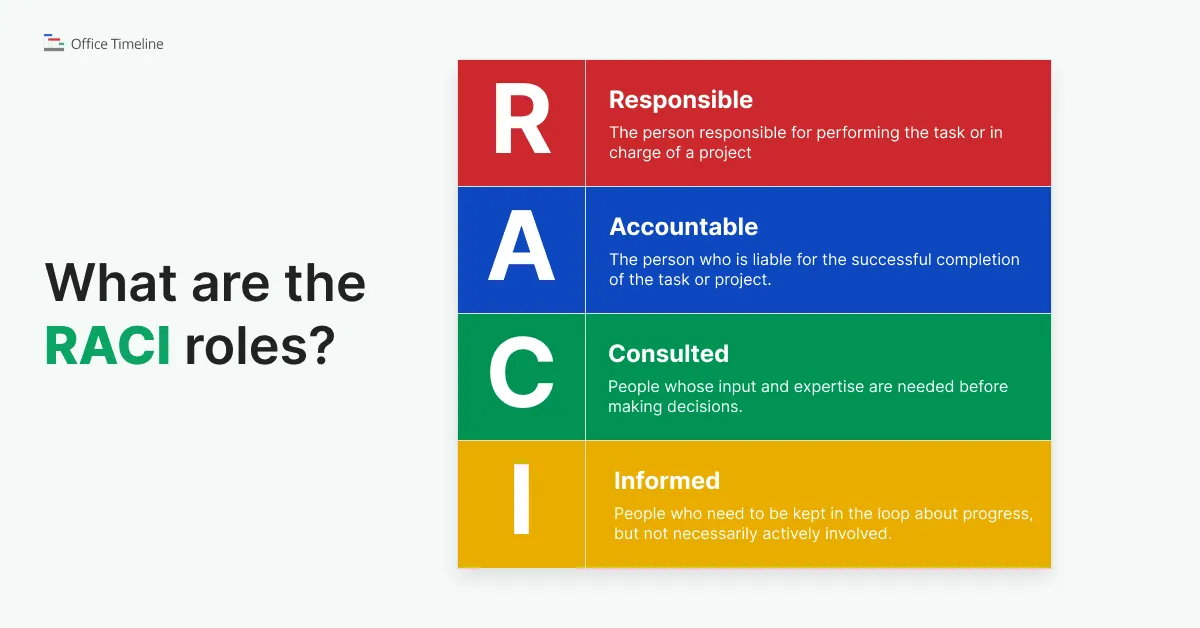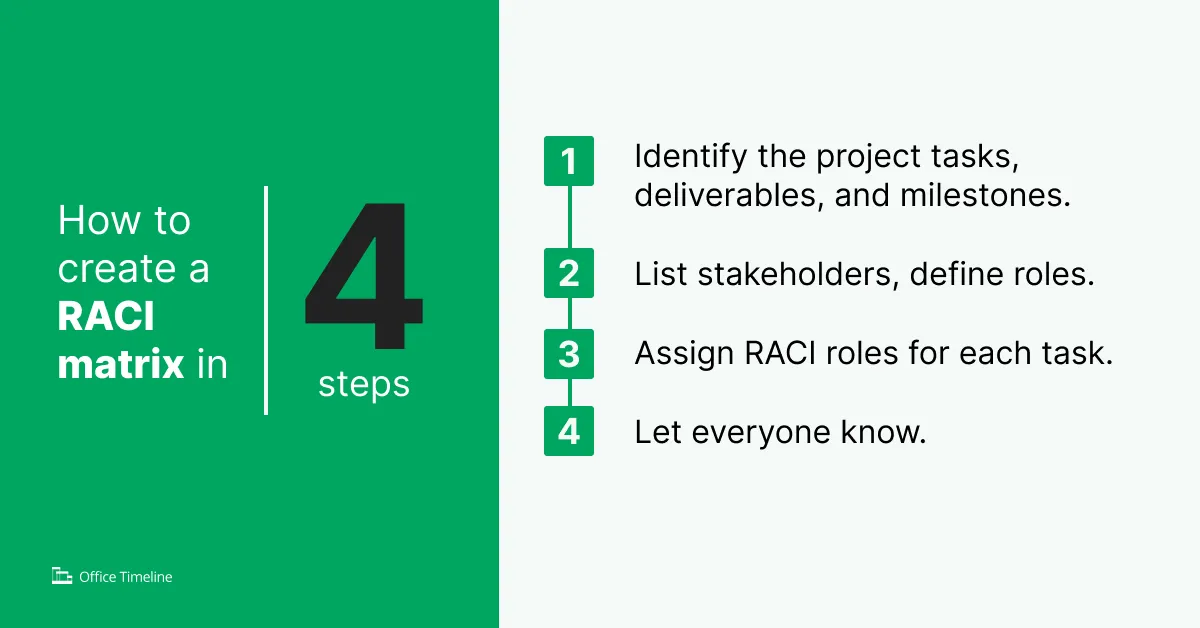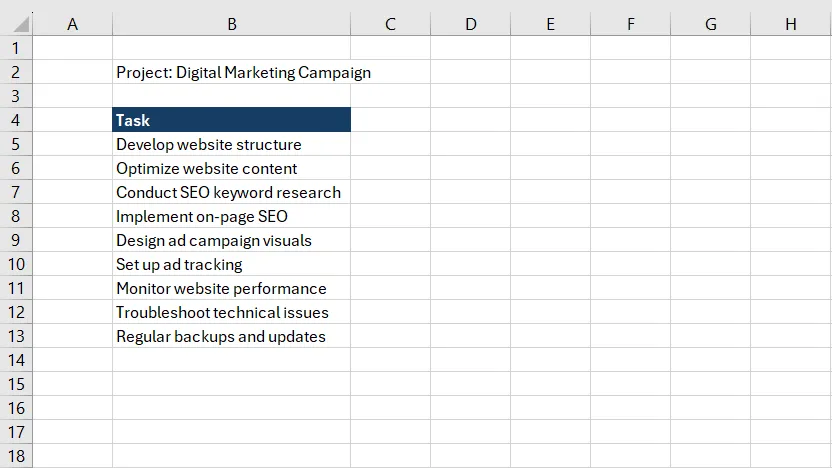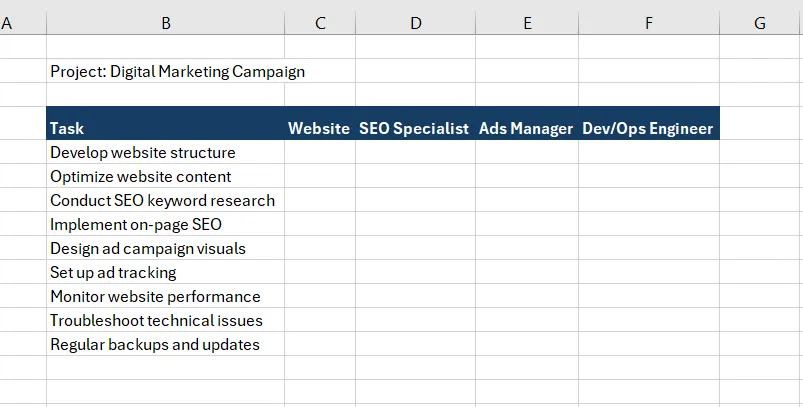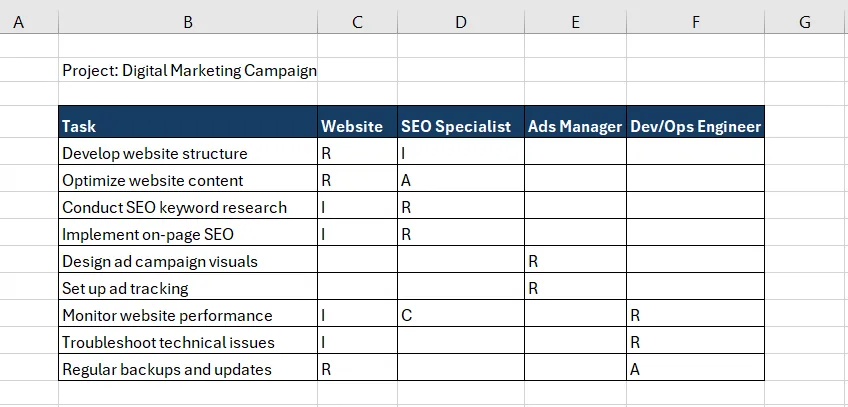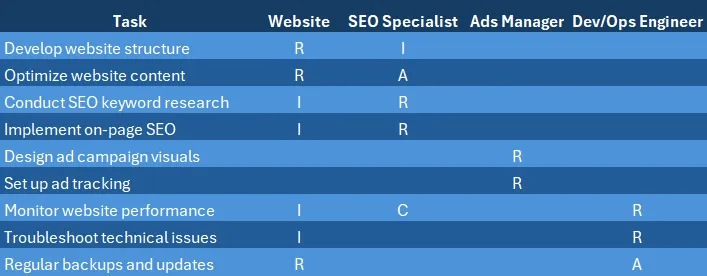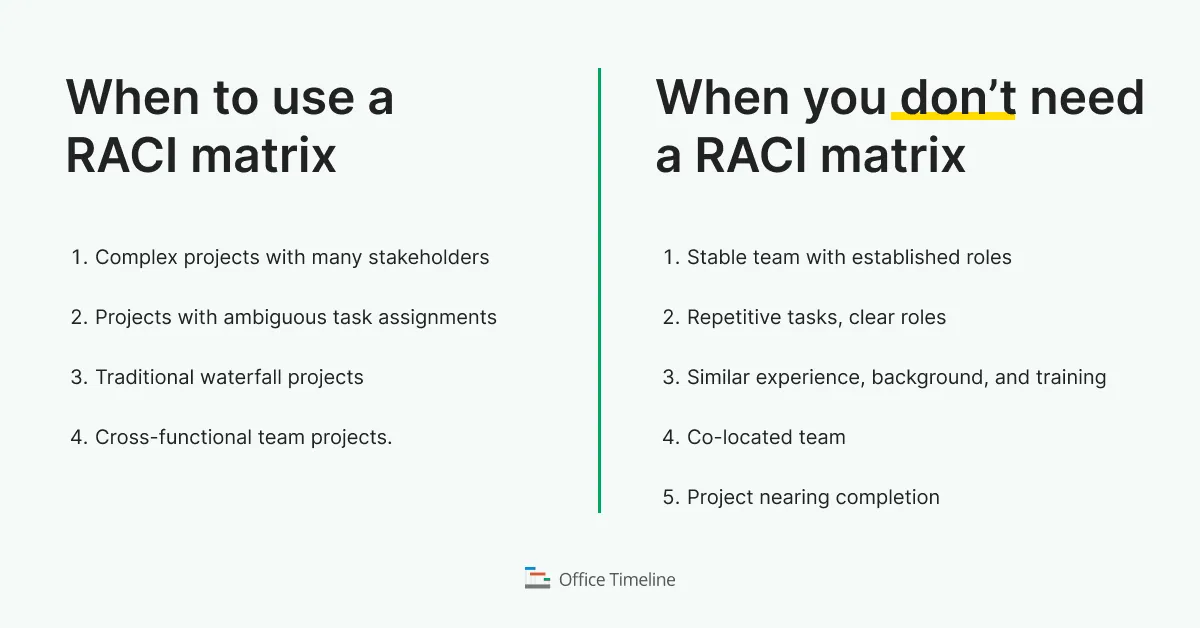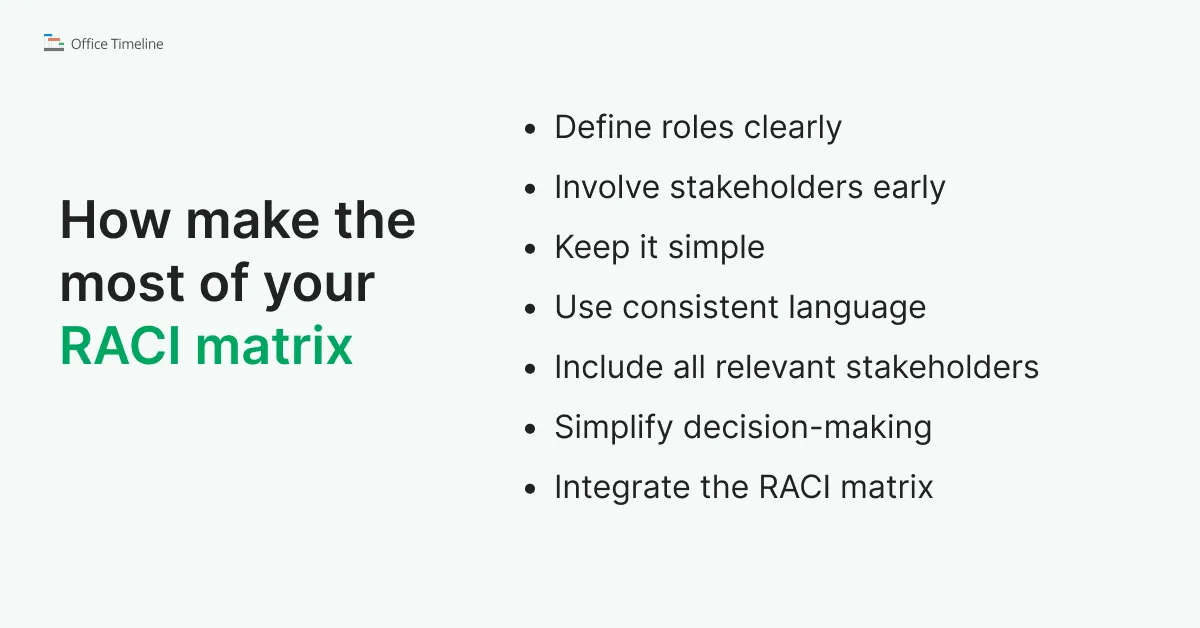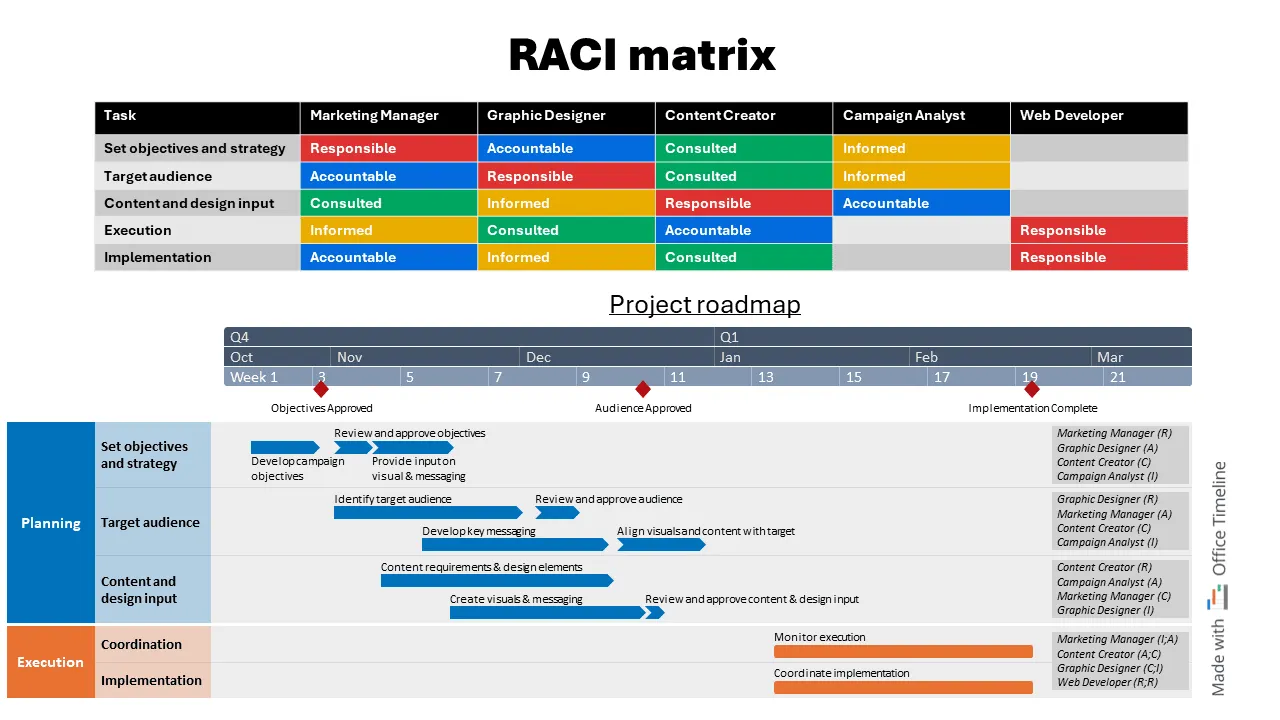Maximizing stakeholder engagement with the RACI matrix
Discover how to use the power of the RACI matrix as a strategy for stakeholder engagement. Download for free our PowerPoint roadmap template.

Project success is never easy. It takes more than just planning and implementation. At the heart of a project are the people involved – the team, the stakeholders. It’s the dynamic of people and roles, and the interactions among them that shape the outcome of the project. That’s where the RACI matrix steps in, guiding everyone in the right direction.
Think of a scenario where not one team but several are tackling complex projects – a mesh of plans and teams dealing with intricate tasks, changing deadlines and requirements. Such a situation might well be the nightmare of a project manager. However, if the team works in sync and everyone knows what to do, this can turn into the perfect dream! Can you turn this dream into reality? Perhaps. But with the RACI matrix in your toolkit? Absolutely!
A RACI (Responsible, Accountable, Consulted, and Informed) matrix is like a clear plan that divides project responsibilities and minimizes confusion within a project. How? You are about to find out.
By the end of this article, you’ll have the resources to help enhance communication among the stakeholders and their involvement in your project, along with a professional free RACI roadmap template.
Stakeholder management and the RACI model
Product managers handling stakeholder relationships often need to set up processes involving multiple stakeholders. Without a framework like RACI, there’s a risk of omitting to include people with important roles in the project (other than execution), ambiguity of roles, too little or excessive communication, and potentially missing important feedback.
Understanding stakeholders is a prerequisite for project success. That’s why all projects should start with performing a stakeholder analysis. Let’s see why the RACI model is a must in stakeholder analysis and how to use it to manage responsibilities effectively and improve stakeholder engagement.
Stakeholder analysis: the first step in stakeholder management
If you’ve ever planned a big event or thrown a party, you will understand stakeholder analysis. For project managers, it is a tool that makes it easier to see who’s on your side, what they want, and how you can keep the good times rolling. By gathering this information up front, you can ensure that the project runs smoothly and that all participants are “in tune” with each other.
After all, this is a nice way of catching things free before they turn into big headaches, maximizing resources and getting people to express their opinion. Let project managers manage the project well and their people enjoy it. So, the project is successful in the end.
In brief, stakeholder analysis is the process of identifying, evaluating, and controlling individuals (or groups) who are affected by a project or affecting it.
For a deeper understanding of stakeholder analysis processes and methodologies, we invite you to explore our comprehensive article on the subject, Stakeholder analysis 101: a project manager’s guide.
RACI is needed to set clear responsibilities, define roles (Responsible, Accountable) and ensure good communication (Consulted, Informed) among stakeholders.
What is RACI?
An important part of the puzzle for taking a project from messiness to success is that everyone understands their responsibilities. Good collaboration among stakeholders, clear roles, and a well-organized team are all top requirements for the success of a project. And this is where the RACI model comes in handy. RACI stands for Responsible, Accountable, Consulted and Informed.
A RACI matrix , also known as a Responsibility Assignment Matrix (RAM), is a project management framework for clearly defining and communicating the tasks and responsibilities of people involved in a project. It is a simple visual representation that helps clarify the confusion project managers face: who is responsible for what (R), where is the accountability (A), who has to be consulted (C), who needs to be informed about project progress (I).
Now we can break this down by the various roles:
Responsible (R)
This is the person in charge of a project, who makes sure the work gets done. They own the project, take the lead in its management and are responsible for doing the work. For example, a project manager is responsible for getting things done and coordinating the project.
Accountable (A)
The person who gives approval for the work and the final say in whether the project succeeds or fails. This person is responsible for making the final decisions and making sure the work is done well. For instance, a project sponsor or executive may be accountable for the success of the project.
Consulted (C)
The ‘Consulted’(C) people/groups are not directly involved with the execution of the project. However, they do have the ability to do the work. They are needed for their expertise to complete the job (subject matter experts.) They are primarily consulted for their feedback or advice. For example, a software development team might consult with a cybersecurity expert to check the security of the project.
Informed (I)
The people or groups listed under ‘Informed’ (I) are those who need to stay up-to-date on the progress of our project. While they are not involved in decision-making or executing, they are kept informed about decisions made and whether the project is still in good shape. For example, team members inform the project’s condition to all major stakeholders by regular reports.
Strong points and weak points of the RACI model
Let’s take a look at what RACI does well and where it may let you down.
RACI’s strong points
The RACI model is a strong tool because it provides a simple way for sorting out who does what in a project, helping teams work better together. Here is why RACI rocks:
- Clear division of labor: The RACI matrix simply and clearly defines people’s roles and responsibilities. It shows who is responsible for what. With the structured framework of the RACI matrix, team members know what their job is. This helps reduce the confusion over who is responsible for what and eliminate misunderstandings, making the work atmosphere more productive.
- Conflict prevention: Avoiding misunderstandings means avoiding conflicts. With the roles clearly delineated, there will be fewer misunderstandings and conflicts. Also, RACI helps avoid duplication of efforts within the team.
- Effective communication: With input on who must be available, who needs to be consulted or kept in the loop, RACI matrices can help team members and stakeholders communicate easily with each other.
- Increased accountability: The Accountable role in a RACI matrix allows project management to concentrate responsibility. In this way, responsibility sticks in one hand and decisions can be made quickly. It also breeds a sense of ownership and increases dedication to the success of the project.
RACI’s weak points
Even if successfully used in a variety of projects, the RACI model can have its drawbacks. Let’s talk about the weaknesses of the RACI model, so that you know where to tread carefully and think strategically.
- Overemphasis on hierarchy: RACI can place too much importance on who’s in charge. This can prevent team members from working together effectively, because communication may feel too formal and rigid.
- Possible confusion between Responsible and Accountable: The distinction between Responsible and Accountable in RACI can sometimes be fuzzy. Responsible means the person who makes sure the work gets done, but the Accountable role (the person who gives the approval) may sometimes be perceived as similar to Responsible, meaning it’s hard to pinpoint who’s ultimately responsible/accountable.
- Risk of misinterpretation: When people interpret the codes differently, the RACI chart can become useless. They can confuse team members about what they’re supposed to be doing, and what everyone else is doing.
- Static nature: On dynamic projects, roles and responsibilities can change over time. RACI matrices are often left in the original form that they were created. Dynamic projects require regular RACI updating. When there is no update system, RACI matrices cannot accurately reflect reality.
The right approach is to see RACI as more of a guide, less of a strict rulebook. In addition, consider taking some common-sense steps, such as clarifying roles from the start, make a point of checking in regularly, and be flexible when responsibilities and roles change. That way, everyone knows who’s where on the map.
How to create a RACI matrix
So, your project is gearing up, and to be sure no one is floundering when it comes time to do their part, you decided you need a RACI matrix. Below is a 4-step process for creating your RACI diagram:
Let’s have a more detailed look at each of these steps.
Step 1: Identify the project tasks, deliverables, and milestones
When creating the RACI matrix, first list all project tasks, milestones, and decision points. Put these in the lefthand column of your RACI template.
Step 2: List stakeholders, define roles
This should solidify the critical roles in your project. Across the top of your RACI chart, note the people involved in the project. Round off your key stakeholder list by including the customer, project manager, contractors, etc. Each role should be clearly defined. This is key to a full understanding of who contributes what to the project.
Step 3: Assign RACI roles for each task
Each task on the list must have a type assigned as R (Responsible), A (Accountable), C (Consulted), or I (Informed) based on the level of participation of your project team members.
Step 4: Let everyone know
Share the final RACI matrix with the whole project team, and make sure they understand their role. Get their approval. The matrix will be used as an indicatory tool for both decision making and work process throughout the project. Make adjustments if and when circumstances change.
When to use a RACI matrix and when you don’t need one
Are RACI charts suitable for all projects? In essence, no. Introducing excessive complexity and intricate processes to small, fast-paced projects may obstruct progress and introduce unforeseen obstacles.
When to use a RACI matrix
There are specific scenarios where the use of RACI matrices proves highly useful:
- Complex projects with many stakeholders
Complex projects often involve multiple stakeholders and complex processes. But when responsibilities are not defined in advance, questions about the roles of those who should not be involved, or whether more layers of approval are needed can lead to confusion. Conversely, in smaller projects where jobs are relatively straightforward, a RACI chart could do more to hinder progress than help it progress.
- Projects with ambiguous task assignments
RACI charts are particularly important for assigning tasks when assignments are there is ambiguity in what and how someone should be involved. When stakeholders are unclear about their responsibilities, the RACI chart provides a good starting point for constructive discussions.
- Traditional waterfall projects
Unlike traditional waterfall projects, agile methodologies, such as Scrum, explicitly define team roles, and the product owner in the project. Waterfall projects are characterized by phase-by-phase development and distinct milestones with many more people involved and increased complexity. In this context, the structured RACI approach becomes a necessary tool for charting roles and providing clear lines of responsibility.
- Cross-functional team projects
For projects with cross-functional teams that require diverse skill sets and expertise, RACI charts can be used to clearly set responsibilities and define roles. Involvement from different departments or functional areas can become bottlenecks. This can raise issues particularly in the case of multinational corporations and specialized business units where there are potential conflicts and differences in status.
Finally, the adoption of RACI varies according to the characteristics of each project. Each organization needs to assess which tools are more appropriate for their particular work style and project management type.
When you don’t need a RACI matrix
Although the RACI matrix is a helpful tool in many projects, there are cases where its use may not be necessary:
- A stable team with established roles
A RACI matrix is not needed when your team has been working together for a while, has a stable structure and has already sorted out roles and working relationships.
- Repetitive tasks, clear roles
If you are doing repetitive tasks, or have formally defined roles, a RACI matrix may be omitted, especially if the work is familiar and does not involve significant process changes.
- Similar experience, background, and training
When team members come from roughly the same professional practices and training, it can lead to informal communication and understanding. In such cases team members’ common language and knowledge base enable them to work together more easily in the absence formal structures and flow charts. A RACI matrix might be less important in such scenarios.
- Co-located team
In a co-located team, where informal conversations are easily facilitated, a formal RACI chart may not be necessary. But if the team is spread out over a wide geographical area, then using a RACI chart can prevent misunderstandings.
- Project nearing completion
With almost finished projects, applying a RACI matrix might not yield significant benefits. Instead, you may want to hold a retrospective RACI conversation about what worked well and what could be improved for the next project.
Using the RACI matrix: benefits and best practices
Let’s take a look at the ups and downs of using the RACI matrix for stakeholder analysis. We’ll check out what it’s good for, the smart moves to make it work, and the challenges you could come across. That way, you will be able to get down to a practical way of using RACI properly to understand and optimally manage your project’s stakeholders.
The value of RACI matrices for stakeholder collaboration
Good project management relies on effective communication. Having a clear understanding of roles helps a lot in creating a good collaboration climate in a team. RACI matrices are not just organizational tools; they’re practical aids that enhance how we work together.
Here is how the use of RACI matrices adds value:
Improved communication with stakeholders
As we’ve already stated, in a successful team consistent communication is a must. What RACI matrices provide is a means of clarifying who must do what, who needs to be in the loop or have a say at each step. This keeps stakeholders engaged at the right times, making sure everyone knows what’s going on and avoiding any communication hiccups.
Shared understanding
RACI matrices aren’t just fancy charts. For everyone involved, they are a practical tool that helps them understand what their role is in the project. Thus, realistic expectations can be set, and everyone is kept on the same page when it comes to project goals. And so, it also keeps disagreements within bounds – or at least they can be anticipated.
More efficient decision-making
Without clear roles, decision-making can get a bit messy. RACI matrices simplify things by spelling out who’s calling the shots. With this approach, decisions are faster to make, everyone knows who is responsible, and the project runs smoother.
How to make the best of your RACI matrix
To benefit from the full potential of your RACI matrix, you’ll need some practical tips to make sure things stay clear in your projects. Here is our compilation of tried-and-true best practices gathered from project managers’ recommendations:
- Define roles clearly. Explain each role (Responsible, Accountable, Consulted, and Informed) as clearly as possible, so everyone in the team is on the same page. Thus, team players know exactly where they stand regarding their own part in the project as well as the contributions of others.
- Involve stakeholders early. People involved in the project should be brought in early, even before or during the creation of the RACI matrix. This creates a sense of commitment and shared ownership right from the beginning of the project.
- Keep it simple. Don’t overcomplicate things. Keep them straightforward. Focus on the tasks, make the matrix clear and user-friendly.
- Use consistent language. Throughout the matrix, the wording should stay the same to avoid confusion and ensure no one has a different understanding of what each role means.
- Include all relevant stakeholders. Identify teams and groups who are involved, even if not directly. Consider those with major impact first and be careful not to leave important people out. Leaving key people out is likely to cause misunderstanding, resistance and lack of support, all things that may harm the success of your project. When everyone feels included like a valued team member, the likelihood of project success increases significantly.
- Simplify decision-making. Clearly state who is in charge of making decisions, so things don’t get stuck when important choices need to be made. This speeds up work and makes things easier by avoiding confusion and making sure decisions are made quickly.
- Integrate the RACI matrix. Integrate the RACI matrix into your project tools smoothly. Connect it with the tools you already use for managing projects. This makes the workflow cohesive.
RACI challenges: fix-it guide
The RACI matrix is a handy tool, but like any other, it has its tricky spots. Being aware of these challenges helps use RACI charts at their best. Let’s see what hurdles could occur and how to deal with them.
Role ambiguity
Sometimes, it can be unclear exactly what ‘Responsible’ means in a particular situation. The Responsible, Accountable, Consulted, and Informed labels can be a bit fuzzy. This can result in uncertainty about who is responsible for what specific tasks or decisions in a project.
How to fix:
- The first thing to do in this situation is to try and make role definitions as clear as you can in your specific context.
- Then communicate everyone involved what are the expectations for the project.
- Another important action that you can take is to document the processes. Why? For each role, documenting steps, responsibilities and associated expectations ensure that all parties understand what each role entails. As a communication tool, it puts everyone on the same page. Also, when the processes are documented, standardized workflows can be implemented, which means clarity and consistency. And on top of these, documenting is an invaluable training and onboarding tool.
- Last, but not least, keep the team informed of all changes regularly. It might be a good idea to create a system that integrates with the workflow, making it a compulsory step.
Together, these steps make things clearer and are a reliable way to avoid confusion.
Involving the stakeholders
Including everyone in creating the RACI matrix can be challenging. If not done, it can impact its accuracy. How? If important team players aren’t part of the process, the matrix might not truly reflect what’s going on in the project. To get a clear and accurate view of how the project works, you need to include everyone who is involved in the project in creating the RACI matrix as well – particularly those with considerable influence or impact over the project.
How to fix:
Here is a three-step model that you can use to ensure stakeholder involvement when working with a RACI matrix:
Step 1: The first step is to identify the key stakeholders. Check out our stakeholder analysis guide for more detailed tips that might help you accurately identify the stakeholders in your project.
Step 2: Once you have finalized the first step, the tricky part is to get all these key stakeholders together in a workshop to define roles. In this workshop, you’ll also gather input and feedback on roles, and then document them together.
Step 3: Ideally, the review and refinement of the RACI matrix should be done collectively as well. Then, whenever the case, the changes within the matrix should be traced and communicated to everyone involved to make sure nothing is missed.
This is what we can describe a collaborative process, designed to gather all perspectives and ensure that stakeholders feel a sense of ownership over the project circumstances.
Resistance to change
Some team members might not be thrilled about switching up their usual processes. Getting everyone on board the RACI matrix can be an uphill battle. This is a frequent challenge among team members when a new approach such as the RACI matrix is introduced.
How to fix:
There are some things you can do to face this resistance head on, the keyword here being “communication”. Here are some suggestions that you might find useful:
- Make a list/presentation of the benefits of using the matrix. Clearly communicate this to all people involved.
- Bring stakeholders into the decision-making process.
- Train everyone so they know what it means and what part they play.
- Share the successes of other projects that successfully used the RACI matrix.
- Consider piloting the RACI matrix on a smaller scale (in a specific project) before full implementation. Thus, team members can experience its benefits firsthand and can make the transition smoother. resolve any issues and then roll it out across the project/department.
- Ensure leadership support.
- Celebrate success. Acknowledge and celebrate the positive impact of the RACI matrix. Take time to discuss and celebrate the improvements resulting from the use of the RACI matrix.
Keeping the RACI matrix updated
Remembering to update the RACI matrix as things change is one of the easiest things to overlook. The RACI matrix needs regular attention to stay relevant as your project moves ahead.
How to fix:
To keep your RACI matrix up-to-date, project managers and team members should consider assigning ownership to a designated individual. Then, establishing a regular schedule for updates. An idea to do this easily is to use automation in your tools. The next action that you could take is set a clear communication protocol to report changes. Also, conducting regular reviews during team meetings, and setting up a feedback mechanism for collaboration might help as well.
Maintaining simplicity
Balancing enough detail without making the matrix overly complicated is a real challenge. Because you don’t want it to be a headache — you want it to be helpful. The challenge is balancing enough detail to make the RACI matrix helpful and, at the same time, keeping it simple and understandable. The goal is to provide a tool that teams can use easily for project management, without creating confusion or making project management overly burdensome.
How to fix:
Here’s what you can do to maintain simplicity in your RACI matrix:
- ensure clear definitions for each role,
- avoid redundancy by limiting the number of roles per task,
- use simple language,
- use a format that is visually clear,
- keep the RACI updated and reviewed regularly,
- think of a feedback mechanism that should enable continuous improvement.
Compatibility with the VUCA framework
RACI charts, which lay out roles and responsibilities in a structured way, can be too inflexible to handle the VUCA (Volatility, Uncertainty, Complexity, and Ambiguity) environment, which changes and morphs rapidly. In unpredictable situations, relying strictly on predefined roles can become an obstacle to agile, quick decision-making, and adaptation; you need flexibility. You need to walk the line between structure and adaptability.
How to fix:
In a VUCA environment that’s always changing and uncertain, using RACI successfully means being able to be flexible and adapt quickly. Think of RACI roles like puzzle pieces; sometimes you might need to move them around as the picture changes. Everyone should be quick to adjust and find a good balance between having a plan (RACI) and being ready for surprises in the ever-changing VUCA world.
Things to consider when using RACI in a VUCA environment:
- Stay flexible. Don’t just stick to the puzzle pieces. In a VUCA environment, it’s all about being able to adapt your roles as quickly as situations change, letting you be responsive to unpredictable changes. Keep RACI roles flexible and update them as the VUCA environment changes, allowing roles to change with the situation.
- Communicate openly. Communicate beyond the formal RACI structure. Share information constantly, stay open and connected. A team that works well together won’t just communicate at the Start and Finish of a project, but will be talking, sharing information and highlighting roadblocks over the life of the project, regardless of predefined roles. This way, the team is always prepared to act quickly together to fix issues in real time.
- Use RACI as a tool for team empowerment. Empowered teams are able to make their own decisions within their expertise. This ensures ownership, responsibility and agility. Overall adaptability is greatly enhanced by empowered teams, which are much better at handling uncertainty. RACI structure can easily be a way to empower your team because RACI makes it clear who has the authority to make decisions but also invites the opinions of all to help influence those decisions.
Integration with project management tools
Making the RACI matrix work well with existing project tools can be a bit of a tech puzzle, potentially causing hiccups in how smoothly it’s adopted. The RACI matrix needs to be integrated with existing project management tools if you aim for streamlined workflows, real-time updates, and — perhaps most importantly — high accuracy. Also, as a direct consequence of integrating the RACI matrix with your regular project management tools, teams will see improved collaboration and will save a lot of time, not having to spend precious time manually updating details in multiple systems. And finally, RACI integration enables information about a project to be distributed across multiple solutions that your team is already comfortable using (rather than forcing them to adopt an additional one).
How to fix:
- The first step to make the RACI matrix work in existing project tools is to find ways to adjust, customize or configure the existing tools to suit the RACI matrix. You may need to look for features or plugins for integration, if available.
- If you’re just beginning a project and plan to use the RACI model, select compatible tools right from the start or find collaboration platforms that support RACI.
- To avoid potential problems, you might want to consider a pilot implementation for testing.
- If team adoption seems to be the issue, start by providing training and ongoing support to team members and use the tips described in section where we discussed resistance to change.
Facing all these challenges head on and figuring out solutions that suit your project best can turn the RACI matrix into your go-to tool for managing and engaging stakeholders. We hope you can use the tips we shared here to help you enjoy the perks of a more powerful, easier to implement RACI matrix, and make your lives a bit easier.
Free downloadable RACI matrix template
To help you kickstart your stakeholder management strategy planning, we’ve prepared a professional-looking template that you can download for free and easily update as desired.
This timesaving template offers an easily digestible visualization of your project roadmap that we’ve enriched, for your convenience, with a RACI matrix. This makes it easier for you to organize responsibilities in a clear form and can significantly improve communication with your stakeholders with minimum effort.
Using and updating the template
This template was created with Office Timeline, our professional PowerPoint timeline maker. You can update and customize this template by adding your tasks and milestones, adjusting dates, incorporating notes and styling the items right in your timeline with the help of the free 14-day trial version of Office Timeline.
Use it to streamline your project visualizations by offering your audience a clear view of the project progress, dependencies, and milestones. Easily create clear and stylish timelines, roadmaps, and Gantt charts ready to be included right into your PowerPoint presentation. Transform complex project data into visually engaging presentations that are easy to make and update.
RACI alternatives
RACI is a widely adopted framework in project management for defining roles and responsibilities. However, since organizations vary in their structures and requirements, they may look for other models that better suit their specific needs and dynamics. Here are some of the alternatives to the RACI framework:
RASCI
Responsible: The team member who is assigned the Responsible role carries out the practical work and completes the task.
Accountable: The person designated as Accountable has the final say on the task’s outcome.
Support: The team member in charge with Support gives assistance or support to the Responsible person.
Consulted: The Consulted stakeholder provides input before a decision is made.
Informed: The Informed person is kept up to date after a decision has been made.
DACI
Driver: Like the Responsible in RACI, the Driver leads the action, executes and ensures that the task is completed.
Approver: This role is comparable to Accountable in RACI. The Approver has final approval/decision and has overall responsibility — they must sign off (Approve) on the task or project before work is executed/concluded.
Contributors: This role is similar to the Consulted role in RACI. The Contributors give input, provide expertise and may support the project, but are not ultimately responsible for the final decision.
Informed: Similar to the Informed role in RACI. The Informed persons get information, are kept “in the loop,” but are not responsible for action or decision in the direction/accomplishment of project.
RAPID
Responsible: The Responsible role is assigned to the person who is performing the task to ensure the goal is achieved. They are hands-on and actively engaging in the required action.
Accountable: This person is accountable for the project’s success or failure. While they do not perform the task themselves, they ensure it gets done and raises to the required standard.
Consulted: The people in this role are the ones that provide input and expertise before the decision is made or the activity is executed. Their insight ensures that the decisions are informed.
Informed: These are the people that are kept in the loop after the decision is made. They are not directly involved in decision making or task execution, but they receive updates on the progress and the outcome of the project.
PARIS
Performer: The Performer is the person responsible for actually doing the work associated with the task. This person does all the necessary actions to get the work done so the task can be completed.
Accountable: The person who holds responsibility for project success. Although the accountable person may need to delegate actions to other individuals to help them get the work done, they have the ultimate responsibility for the project and make sure it meets the required standards and objectives. In some cases, the accountable person could also be the person who performs the task (delegation of the Performer role does not relieve the accountable person).
Reviewers: The Reviewers contribute by providing insights, suggestions, and expertise after reviewing the work done. They have a say on the task’s quality and need to check it to agree on whether the work is ready to go forward to the next step.
Input: These people inform the person accountable for getting the task done as to what is going on in the project, provide input, share information, advice, suggestions, and expertise on the matter at hand so that a more informed decision-making process can be performed.
Sign-off: This person gives formal approval before work can proceed. The signer-off gives their formal endorsement and says the work is acceptable to proceed into the next phase, or just that the work is complete.
In summary, by exploring alternatives to the original RACI model, organizations can consider other options that align with their specific project parameters and team dynamics. These alternative models — RASCI, DACI, RAPID and PARIS — offer targeted benefits depending on need. RASCI includes a Support role. DACI introduces decision-making roles. RAPID adds detail regarding the importance of input and drivers in the decision making and PARIS is even more detailed in terms of those who should be Responsible, Accountable, Sign-Off, Input and Support.
Overall, these alternatives have a lot of common points, being variations of the same theme. Yet, each of them introduces its own approach to various combinations, as can be seen by comparing the models. Depending on the nature of the project, the parameters of the team or the types of decisions being made, each alternative adds and nuances roles that may reflect more accurately the needs of diverse projects.
Conclusion
Wrapping up our discussion about RACI matrices , it’s worth noting that, under the right circumstances, the RACI model can prove valuable in a diversity of projects, especially in managing stakeholder engagement and enhancing communication. It’s not rocket science, it just helps keep things clear, making sure everyone knows their role and offers a practical understanding of the hierarchy of importance in a project. By sorting out who’s responsible, accountable, consulted, and informed, strategies are greatly simplified and a lot easier to implement.
Project managers can consider this tool as a practical addition to their repository. A simple but efficient aid that gets the job done in an easier way. It probably won’t make headlines, but it might just make your project’s path a bit smoother and your life a lot easier.
Frequently asked questions about the RACI matrix
Still have questions about RACI matrices? We've got you covered with answers to some of the most commonly asked questions about the RACI matrix. Check them out below.
RACI stands for Responsible, Accountable, Consulted, Informed:
Responsible (R) – The person responsible for performing the task or in charge of a project.
Accountable (A) – The person who is liable for the successful completion of the task or project.
Consulted (C) – People whose input and expertise are needed before making decisions.
Informed (I) – People who need to be kept in the loop about progress, but not necessarily actively involved.
In the RACI matrix, the Responsible (R) role is assigned to individuals responsible for performing the task or activity. Those in the R position are the ones actively executing and completing the work. They are the doers.
The Accountable (A) role is assigned to the person answerable for the successful completion of the task or activity. The Accountable person is the one who makes the final decisions, ensures that the work is done, and takes responsibility for the outcome.
While the Responsible are actively performing the work, the Accountable person oversees the process and ensures it aligns with overall goals and standards.
In the RACI matrix, C signifies Consulted, designating persons or groups who have essential abilities or knowledge necessary for task completion. This may involve stakeholders, subject matter experts, or other key contributors whose input is sought before actions are taken. Although not directly executing the task, their insights significantly contribute to informed decision-making.
The main benefit of creating a RACI chart is to provide clarity and structure in defining roles and responsibilities within a project. It helps avoid confusion by clearly outlining who is Responsible, Accountable, Consulted, and Informed for each task. The RACI chart improves communication, accountability, and collaboration.
The RACI matrices are not considered outdated. Widely used in project management and business processes, RACI charts clarify roles and responsibilities. Including a deadline column for time-bound clarity enhances their effectiveness in managing tasks within specific timeframes. However, while effective, their creation requires thoughtful use due to the time investment¸ so use them wisely.
RATSI and PACIS are alternative variations of the traditional RACI matrix used in project management to improve it and provide clearer role definitions.
RATSI (Responsible, Accountable, Task, Support, Informed) offers a more nuanced matrix and enhances clarity introducing a support role. RATSI refines the traditional Responsible and Accountable pair by adding Authority and Task.
PACIS (Perform, Accountable, Control, Suggest, Informed) is a way to organize tasks in a project and places a strong emphasis on result examination. PACIS is good when you need to carefully check and confirm results across the whole organization. This helps to avoid problems and disagreements by making sure everything is thoroughly examined and understood.
RACI (Responsible, Accountable, Consulted, Informed) is not exclusive to Six Sigma but is often used within the methodology to clarify roles and responsibilities in project management. Six Sigma primarily emphasizes statistical analysis and data-driven decision-making. RACI is a versatile tool that can be used in various project management contexts, including Six Sigma. It provides a clear framework for clearly defining and communicating responsibilities within a team, particularly in the Define and Measure phases of the DMAIC framework. Integrating RACI enhances collaboration and communication within Six Sigma projects.
Yes, RACI is compatible with Agile methodologies like Scrum and Kanban. It adds clarity to roles and responsibilities, enhancing communication and collaboration within Agile teams, especially in larger or complex projects.
While the RACI (Responsible, Accountable, Consulted, Informed) model is widely used, it has its weaknesses. Here are the main concerns about RACI:
• Ambiguous accountability levels
Differentiating Responsible and Accountable roles can create ambiguity in defining accountability.
• Limited detail on consulted and informed roles
Consulted and Informed roles lack specificity, offering limited guidance on involvement and information sharing.
• Overemphasis on hierarchy
RACI’s hierarchical nature may hinder collaboration, focusing excessively on authority.
• Static nature and risk of misinterpretation
RACI matrices can become outdated, and there’s a risk of team members interpreting codes differently, leading to potential role misinterpretations.
Deciding to use the RACI model depends on how complicated a project is, whether people need clear roles, and how well the team works together. RACI is helpful when projects are tricky, involve lots of people, or need different teams to collaborate. It makes sure everyone knows their job and helps with talking to each other. It’s really good during big changes in a company because it gives a clear plan. Whether you need it or not depends on how big the project is, how many people are involved, and how the company works. Some projects might do better with different plans.
To do a RACI exercise, follow these steps:
1. Identify tasks. List all the tasks or activities relevant to your project or process.
2. Determine roles. Identify the roles or positions involved in each task.
3. Assign RACI values. For each task, assign RACI values (Responsible, Accountable, Consulted, Informed) to the respective roles.
4. Clarify RACI definitions. Ensure a clear understanding of what each RACI value means in the specific context of your project.
5. Document the matrix. Create a visual RACI matrix to represent the assigned roles for each task.
6. Communication. Share the RACI matrix with the team to ensure everyone is aware of their roles and responsibilities.
7. Iterate as needed. Be open to adjusting the RACI matrix based on feedback, changes in project dynamics, or lessons learned during the project.
A RACI exercise helps clarify and document the involvement of each team member in various tasks of a project.
Yes, it is possible to have blanks in a RACI matrix. The absence of an assignment for a particular role and task indicates that the individual or group associated with that role is neither responsible, accountable, consulted, nor informed for that specific activity. However, it’s important to use blanks wisely and ensure that key tasks have appropriate RACI.
In the traditional RACI model, an individual typically cannot hold both the Responsible and Accountable roles for the same task. The Responsible role is for those directly performing the task, while the Accountable role is for someone ultimately answerable for the task’s success or failure. This separation ensures clarity and accountability within the project. Having one person in both roles might create ambiguity about who is ultimately answerable for the task’s outcome. However, project-specific variations might allow for more flexibility.
In a standard RACI matrix, it’s not common for two people to be designated as Responsible for the same task. It needs to ensure clear ownership. The Responsible role usually signifies the individual or team directly performing the task. However, variations of the RACI model or project-specific adaptations may allow for flexibility in certain cases.
Project management tips and tricks
Turn project data into professional timelines
Get the advanced features of Office Timeline free for 14 days.



